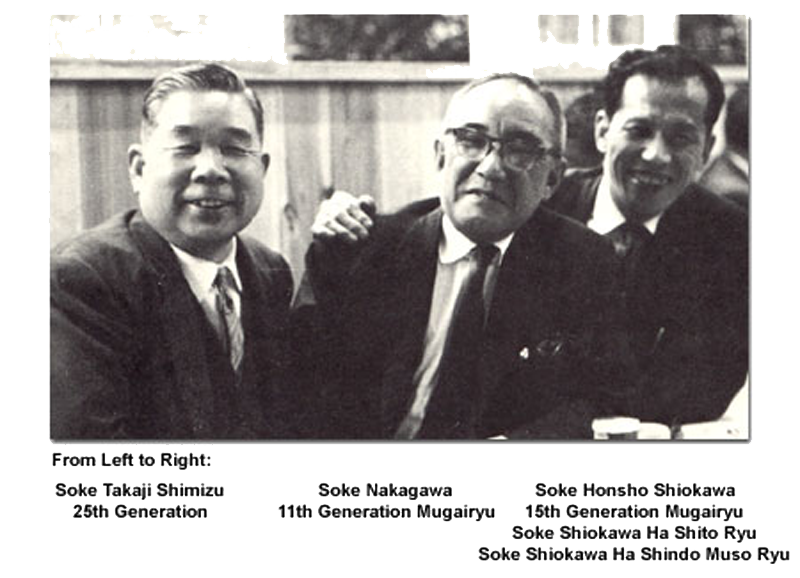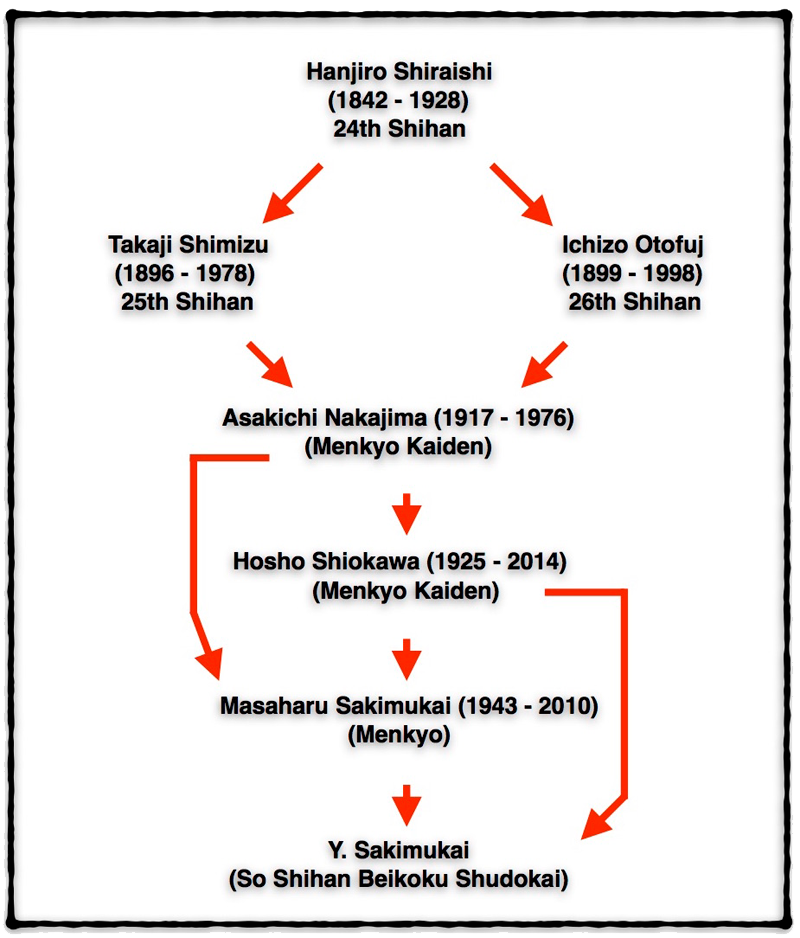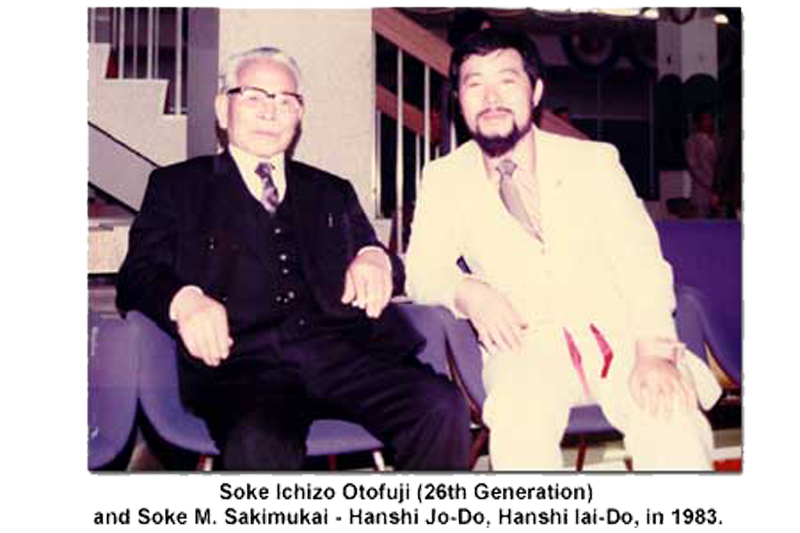Jodo History
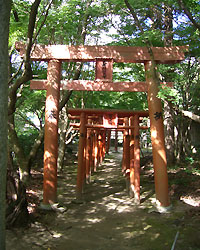 Shindo Muso Ryu or "Shinto Muso Ryu," hereafter referred to as SMR is known to have found by Muso Gonnosuke Katsuyoshi, a samurai of the early 17th century. According to "Jodo Kyohan" written by Shihan Shimizu Takaji who is widely considered to be the 25th Headmaster of SMR Jojutsu, Muso Gonnosuke received the Tenshinshoden Katori-Shinto Ryu Kenjutsu (sword style) Menkyo (full license) and also studied under Matsumoto Bizennokami, founder of the Kashima Shin Ryu Kenjutsu, and mastered its secrets thus given completion of the style, “Ichi no Tachi” also referred to as "Kashima no Tachi." Muso Gonnosuke was a master swordsman.
Shindo Muso Ryu or "Shinto Muso Ryu," hereafter referred to as SMR is known to have found by Muso Gonnosuke Katsuyoshi, a samurai of the early 17th century. According to "Jodo Kyohan" written by Shihan Shimizu Takaji who is widely considered to be the 25th Headmaster of SMR Jojutsu, Muso Gonnosuke received the Tenshinshoden Katori-Shinto Ryu Kenjutsu (sword style) Menkyo (full license) and also studied under Matsumoto Bizennokami, founder of the Kashima Shin Ryu Kenjutsu, and mastered its secrets thus given completion of the style, “Ichi no Tachi” also referred to as "Kashima no Tachi." Muso Gonnosuke was a master swordsman.
One story tells while staying in Hitachi no Kuni (north of Tokyo) under Yoshikatsu Sakurai's Shinto Ryu Kenjutsu dojo, Gonnosuke became quite the sword expert defeating countless challengers. But one day, Gonnosuke had the match of his life with all-time greatest master swordsman, Miyamoto Musashi (author of "Book of Five Rings") at Banshu Akashi. According to its legend, during this match Gonnosuke's bo strike was caught by Musashi's Niten-Ichi Ryu Jujidome, a mystery technique of two swords block in cross pattern. Gonnosuke could neither advance nor retreat, locked and unable to move. Though Gonnosuke was not killed, he was defeated for the very first time.
Birthplace of Jodo
Gonnosuke had suffered hardships for his defeat against Musashi. He retreated to a cave at the holy Mt Homan (3,000-ft) in Fukuoka to seek spiritual guidance. Gonnosuke meditated and endured austere training for 37 days at the Muso - Fuchi cave. On the 37th day, Gonnosuke dreamed of receiving a divine vision that a boy (Ojizo) instructed him to shorten his 6 ft bo to a 4 ft length.
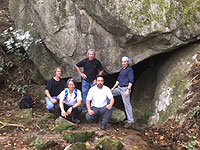 Right Photo - In front of the (Muso) Fuchi Cave, 2015
Right Photo - In front of the (Muso) Fuchi Cave, 2015
"Hold a round stick and understand the solar plexus.” 「丸木をもって水月を知れ」 "Maruki o motte suigetsu o shire" It is believed that Gonnosuke was given five techniques known as the "Gokui" during a dream. Gonnosuke devoted himself to the conquest of Musashi’s Niten-Ichi Ryu Jujidome with his freshly made oak staff a new weapon of his choice, which originated the art "Jojutsu."
Jo is like having a weapon with three features all in one, Yari (a spear), Naginata (like Chinese halberd with blade slightly wider) and Tachi (a long sword). Also, Jo has about a foot in length advantage over the regular length sword (3' 2"). Gonnosuke was ready to challenge Niten-Ichi Ryu Jujidome for the second time, and he would defeat Musashi with the technique inspired by the divine message. Hirano Jiro Kuniomi wrote it was a tie. It is said after defeating the famous swordsman Musashi, Gonnosuke became a weapon instructor to the Kuroda Clan (Daimyo), a powerful lord in Kyushu Island, Fukuoka. Jojutsu was strictly maintained as an art taught exclusively to this Kuroda Clan during the entire Edo period.
Background on Current Jodo
In 1871, samurai era ending by the political system change known as "Meiji Restoration," the restriction of the Jojutsu training was inevitably lifted and the opportunity was granted to the SMR masters to introduce the art to public outside of Kuroda Clan in Kyushu (Fukuoka) for the very first time.
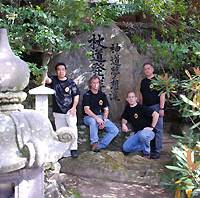 Among the first were Kuroda Hanshi; Ryogoro Uchida (founder of Uchida Ryu Tanjojustu) and Kohachi Takeuchi, they moved to Tokyo and introduced SMR Jojustsu. Among their notable student was Hakudo Nakayama (a legendary sword master and founder of Muso Shinden Ryu Iaido), who later earned Hanshi in Jodo.
Among the first were Kuroda Hanshi; Ryogoro Uchida (founder of Uchida Ryu Tanjojustu) and Kohachi Takeuchi, they moved to Tokyo and introduced SMR Jojustsu. Among their notable student was Hakudo Nakayama (a legendary sword master and founder of Muso Shinden Ryu Iaido), who later earned Hanshi in Jodo.
Hakudo Nakayama was also Hanshi in Kendo as well as Iaido, and he was known as the "San (three) Do Hanshi." Today, there are active groups promoting Hakudo Nakayama's off-mainstream Jodo in the Kanto Region.
Meanwhile, Shihan Hanjiro Shigeaki Shiraishi (1842-1928), also a Kuroda Hanshi and widely accepted as the 24th SMR Headmaster remained in Fukuoka to oversee the continuance of SMR tradition.
After the 24th Headmaster Shihan Shiraishi passed away, Shihan Takayama Kiroku started the SMR Jojutsu Honbu dojo in Fukuoka where at first the 25th SMR Headmaster Shihan Takaji Katsuyasu Shimizu (1896-1978) served as his assistant. Around 1930, Shihan Shimizu left Fukuoka to devote his greatest effort in popularizing SMR Jojustu in Tokyo, Japan and throughout the world. As a result, when Shihan Shimizu moved to Tokyo his contemporary who is widely accepted as the 26th SMR Headmaster Shihan Ichizo Katsunori Otofuji (1899-1998) was chosen to assist Shihan Takayama at Jodo Honbu Dojo in Fukuoka. Additionally, Shihan Otofuji's brother was sent to Hyogo prefecture.
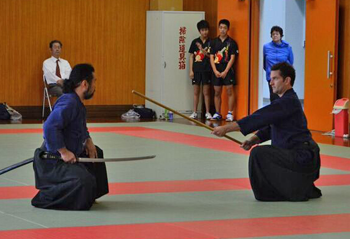 In Tokyo, Shihan Shimizu trained several groups including Judo, Iaido, Kendo and etc instructors at the Kodokan Judo Headquarters as well as Tokyo Metropolitan Police Department, Tokyo Fire Department, students at academic schools, Youth groups, police academies and so forth. This effort was very important for the SMR and stamped its root as one of very respected Japanese budo. Also, by influence of the budo movement changing Jutsu 術 to Do 道 , Shihan Shimizu changed the art's name from Jojutsu to JODO. However, ironically, this effort also contributed to division of the SMR Tokyo side, and the SMR Fukuoka (Kyushu) side. Today, this division extended to several factions stylistically and regionally.
In Tokyo, Shihan Shimizu trained several groups including Judo, Iaido, Kendo and etc instructors at the Kodokan Judo Headquarters as well as Tokyo Metropolitan Police Department, Tokyo Fire Department, students at academic schools, Youth groups, police academies and so forth. This effort was very important for the SMR and stamped its root as one of very respected Japanese budo. Also, by influence of the budo movement changing Jutsu 術 to Do 道 , Shihan Shimizu changed the art's name from Jojutsu to JODO. However, ironically, this effort also contributed to division of the SMR Tokyo side, and the SMR Fukuoka (Kyushu) side. Today, this division extended to several factions stylistically and regionally.
Despite this further division of the Tokyo side and the Fukuoka side, after passing of Shihan Shimizu, our teachers considered Shihan Otofuji from the Fukuoka side to be the 26th SMR Headmaster and recognized him as the next highest authority in Jodo/Jojutsu. Some says a separate lineage from Shihan Shimizu should be given to Shihan Otofuji and call him the 25th Headmaster. There was a meeting between the successors of Shihan Shimizu of the Tokyo side and Shihan Otofuji of the Fukuoka side attempting to collaborate the two sides, however this effort did not succeed. .
As many Jodo/Jujutsu practitioners from all sides attempted to promote only their side of the story so the truth is scattered. Unfortunately, a controversy is quite common in our lives.
The Beginning of Beikoku Shudokai
In 1962, Osaka, Japan, Hanshi M. Sakimukai and Shihan Zenji Shimabukuro began learning Shindo Muso Ryu Jodo from Hanshi Asakichi Nakajima in Osaka; however, on their first visit they were told too young to practice Jojutsu. Since persistence is minimum talent required to pursuit Budo correctly, they returned and asked him for the permission again, only this time young Sakimukai and Zenji Shimabukuro told Hanshi Nakajima that they were both Karate-Do instructors and budo was their profession.
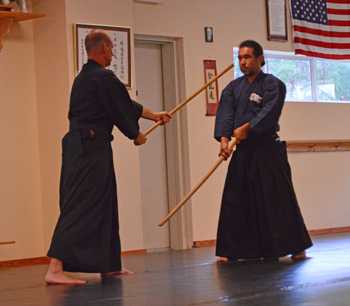 Shihan Nakajima accepted them to be his students in Shindo Muso Ryu Jodo, and he introduced Soke Hosho Shiokawa, Menkyo Kaiden, because of their shared Karate-do profession.
Shihan Nakajima accepted them to be his students in Shindo Muso Ryu Jodo, and he introduced Soke Hosho Shiokawa, Menkyo Kaiden, because of their shared Karate-do profession.
Shihan Asakichi Nakajima (1917-1976), Shindo Muso Ryu Menkyo Kaiden, was a top student of Shihan Shimizu. It was at Shihan Nakajima's group in Osaka young M Sakimukai met Soke Hosho Shiokawa, a top student of Shihan Nakajima, as well as a student of Shihan Shimizu, Shihan Otofuji as well as Shihan Hamaji. Soke Hosho Shiokawa was already the Headmaster of Mugai-Ryu Iai Hyodo and also the high rank achiever of several other traditional Japanese and Okinawa martial arts.
Additional Note: There is active groups in Kansai region promoting Shihan (Hanshi) Asakichi Nakajima as the 26th Headmaster of SMR Jodo succeeding Shihan Takaji Shimzu
Soke Hosho Shiokawa's Budo credentials prior to 1962.
1953 - 5 Dan in Kendo at the first Zen Nippon Kendo Renmei examination after WWII.
1958 - "Shihan" and 7 Dan in Shito Ryu Karate-do from 2nd Soke Mabuni.
1960 - 5 Dan in both ZNKR Iaido and Jodo, the highest ZNKR Dan allowed at the time.
1961 - Appointed to be the 15th Soke of Mugai Ryu Iai Hyodo.
In 1973, while living in Japan, Hanshi M. Sakimukai became one of many Soke Hosho Shiokawa's Jodo and Iaido representatives. However in 1980, he received the exclusive Jodo representation for Soke Shiokawa in the USA as well as Western hemisphere. Then, In 1982, the first Beikoku Shudokai Jodo Club was established in Delaware. Dojocho T. Sakimukai and Y. Sakimukai were among the first Hanshi M. Sakimukai's Shindo Muso Ryu Jodo students. In 1991, USA Jodo Federation - Beikoku Shudo Kai Honbu along with Chintokan So Honbu moved to Jacksonville, FL. The following year, Hanshi M. Sakimukai received the eighth "Menkyo" issued by Shihan Ichizo Otofuji and this is the only Menkyo ever to be presented outside of Japan by both 25th and 26th Head Shihan of SMR Jodo and Jojutsu. The Beikoku Shudo Kai Honbu Dojo was officially recognized as the premier Shindo Muso Ryu Jodo dojo outside of Japan by the 26th Headmaster in 1992, and continued this status till 1998 when Otofuji Shihan passed away. We continue to carry on that legacy.
